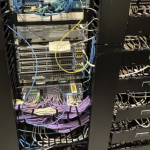
Hybrid Smart Hands: Combining Remote & On‑Site Support for 24/7 Uptime
The Evolution of Smart Hands
Traditional Smart Hands services have operated in two distinct ways:
Remote support teams handle tasks like system monitoring, configuration changes, and troubleshooting without physically being at the site.
On‑site technicians manage tasks requiring direct physical access, such as replacing hardware components, re‑cabling, or moving equipment.
While both approaches have their strengths, relying solely on one can create delays or inefficiencies. The hybrid Smart Hands model blends these two, offering the agility and responsiveness modern data centres need.
Why the Hybrid Model Works
The hybrid approach provides a balance between speed, cost, and effectiveness:
Cost‑Efficient Operations – Reduce the need for full‑time on‑site staff by resolving many issues remotely.
Faster Response Times – Remote teams diagnose and resolve problems instantly, escalating only when physical presence is required.
24/7 Coverage – Global remote teams monitor systems continuously, supported by local on‑site staff for emergencies.
Reduced Downtime Risk – Issues that can’t be fixed remotely are escalated to on‑site teams without delay.
Proactive Monitoring and Intervention
In a hybrid setup, remote monitoring tools track performance, security, and system health around the clock. This allows teams to:
Detect anomalies early before they disrupt operations.
Schedule preventive maintenance visits from on‑site staff.
Optimise resources by sending technicians only when truly necessary.
Best Practices for Implementing Hybrid Smart Hands
Organisations adopting this model should:
Define Clear Escalation Procedures – Ensure both remote and on‑site teams know exactly when and how to escalate issues.
Use a Unified Ticketing System – Keep communication centralised and transparent between both teams.
Conduct Joint Training Sessions – Align skills and knowledge so both teams operate seamlessly together.
Tailor SLAs to Business Needs – Match response times and service scope to the criticality of each facility.
A Future‑Proof Support Model
As data centre infrastructure becomes more complex and uptime requirements more demanding, the hybrid Smart Hands approach delivers flexibility, resilience, and cost control. By combining the strengths of remote expertise with rapid physical intervention, organisations can ensure continuous, optimised operations, no matter the challenge.




